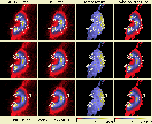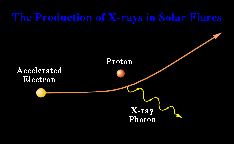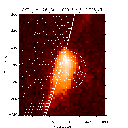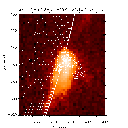A Splendid Limb Flare
Science Nugget: October 29, 1999
Introduction
This week we obtained observations of a flare under a combination of circumstances
which allowed a very nice view. The flare occurred in an active region
which was passing over the west limb of the Sun. We were fortunate enough
to have both Yohkoh SXT observations and excellent Yohkoh HXT
(Hard X-ray Telescope) data from this event. This lucky combination of
a strong flare, on the limb, is perfect for looking at loop evolution in
profile, and watching the expulsion of material. It is also ideal for seeing
faint hard X-ray coronal sources, if they are present. And in this event
we observed an 'above-the-loop' hard X-ray source, or 'Masuda' source.
The flare also showed many dynamic phenomena in SXR such as expanding loops
and the ejection of material.
SXT Movies from 26-October-1999
The SXT movies of this event show some fascinating motions and loop expansions.
In the quarter-resolution images (linked below), great large loops can
be seen billowing outwards, finally extending beyond the field of view
(i.e., beyond 640 thousand kilometers). Underneath, smaller loops can be
seen roiling and moving, lighting up with hot gas. This inner region is
better revealed by the half-resolution images, also linked below. Near
the very center of the images, one can see the repeated expulsion of material,
as one loop after another expands and appears to open up to space. Higher
up, one sees the taller loops in violent motion. Is this in response to
the ejection of material underneath these taller loops? Or is it a result
of the changes in magnetic field connections/configurations which must
be going on in the region?
Notice in the half-resolution movie the material which seems to be "re-directed"
towards the south (downwards), so that it can escape towards the bottom-righthand
corner. Also note the appearance of some loops to the righthand side (also
in half-res, but barely discernible in quarter-res) which seem to initially
retract downwards before subsequently expanding outwards. Are these
merely illusions, due to limited temporal and spatial resolution? Or are
these real physical motions? We suspect the latter, but it's too early
to know for sure.
The 26-October-1999 `Masuda' source
First of all, what is a `Masuda' source? The `Masuda' source is named after
Japanese solar physicist Satoshi Masuda who discovered the presence of
blobs of hard X-ray emission formed high up in the corona, during
some flares. This was a very exciting discovery for solar flare physics.
To see the original Masuda source, from 1992, click here:

Hard and Soft X-ray emission
What is meant by `hard' X-ray emission? 'Hard' and 'soft' describe the
energy of X-ray photons detected. The division is a bit fuzzy, but most
solar physicists would describe a photon of 15keV or above as `hard', and
a photon of 1keV or below as `soft' (however, X-ray astronomers,
studying accreting white dwarfs for example, happily describe a 2keV photon
as `hard'). It's all a bit arbitrary, and the division in solar physics
really refers to what we think is the generation process for these photons.
Generally, we explain soft X-ray photons as bremsstrahlung emission produced
by the rapid and continuous motions about one another of the charged particles
in a hot plasma. The energy of the photon is related to the speed of the
electron, which in turn is related to the temperature of the plasma. A
1 keV photon corresponds to a temperature of about 7.7 million Kelvin.
 Click them image to link to NASA's solar flare theory pages, where bremsstrahlung
radiation and many other aspect of flare theory are explained.
Click them image to link to NASA's solar flare theory pages, where bremsstrahlung
radiation and many other aspect of flare theory are explained.
Yohkoh HXT observes photons between 14 and 93keV. Photons above
20keV, if generated by a hot plasma, would correspond to a temperature
of hundreds of millions of degrees, and most of the time we don't expect
these temperatures to be present. We think instead that this emission is
also bremsstrahlung radiation but generated by electrons accelerated to
close to the speed of light, which stream out of the flare acceleration
site, through the solar plasma, emitting as they go. So when we see
hard X-ray emission, we are see where these accelerated particles are,
and may be able to deduce where they came from.
Most hard X-rays are emitted from the lower regions of the atmosphere,
where the density is high and the emission strong. But the Masuda sources
are high up in the corona, above the location of the soft X-ray flare loops.
This is just what is seen in our 26-October-99 event.


The two images above are from the early phase of the flare. The left-hand
image is an overlay of the contours of the HXT Lo channel emission (14-23keV)
on the SXT loops. The Lo channel emission is kind of amorphous, and mostly
just maps the SXT emission. The right-hand image shows the contours of
the HXT M1 channel (23-33keV) on the same SXT image and is resolved into
3 bright sources. One looks like a loop footpoint, as it is inside the
limb of the Sun. Another is around the bright kernel of the SXT flare loop,
but may also be another footpoint. But the furthest right source appears
above the strongest SXT emission. This, we think, is a `Masuda' source.
Notice that it appears near the site where blobs of material are observed
to be ejected in the SXT movies. Could this be significant?
There have been many explanations for these above-the-loop HXR sources.
Some people think that they are in fact caused by super-hot plasma
at a temperature of 200 million Kelvin. Others think that they are generated
by trapped, accelerated particles. Perhaps this flare will tell us more?
David McKenzie <mckenzie@physics.montana.edu>
Lyndsay Fletcher <fletcher@sag.lmsal.com>
October 29, 1999
 Click them image to link to NASA's solar flare theory pages, where bremsstrahlung
radiation and many other aspect of flare theory are explained.
Click them image to link to NASA's solar flare theory pages, where bremsstrahlung
radiation and many other aspect of flare theory are explained.